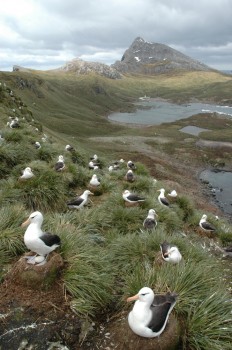
Black-browed Albatrosses on Bird Island, with the research station and Roché Peak behind
Bird Island in the sub-Antarctic South Atlantic was named by Captain James Cook, who sailed past on 14 January 1775 on his second great voyage of exploration. The island is separated from the main island of South Georgia (Islas Georgias del Sur)* by a narrow channel (Bird Sound) which has ensured that unlike the main island it has no introduced rodents. Consequently, although less than 5 km long and 800 m wide, Bird Island holds a huge number and diversity of seabirds, including seven ACAP-listed species. A research base has been long maintained on the island, and each year counts are made of all the breeding pairs of Wandering Albatrosses Diomedea exulans and of birds in five colonies of Black-browed Albatrosses Thalassarche melanophris, eight colonies of Grey-headed Albatrosses T. chrysostoma and in well-demarcated study areas of Light-mantled Sooty Albatrosses Phoebetria palpebrata and Northern Macronectes halli and Southern M. giganteus Giant Petrels. There are also intensive ongoing demographic studies of Wandering, Black-browed and Grey-headed Albatrosses and of both species of giant petrels. The seventh ACAP-listed species that breeds on Bird Island is the burrowing White-chinned Petrel Procellaria aequinoctialis.
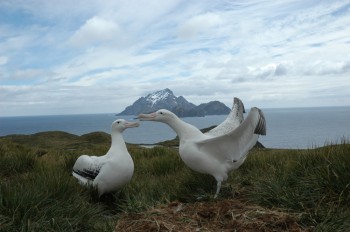
Wandering Albatrosses display on Bird Island, with the Willis Islands in the background
In 2013 just over 700 pairs of Wandering Albatrosses bred at Bird Island, which represents a decrease of 60% since the early 1960s. The Wanderer is an extremely long-lived species, and recent analyses of long-term monitoring data indicate that breeding performance declines after a certain age, but then shows a sudden improvement in the very last breeding attempt. This may be because adults increase the effort they put into rearing just before they die – a pattern which is predicted by theory, but has been rarely recorded in the wild (click here).
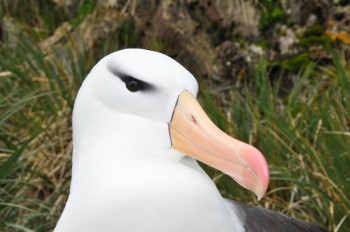
Currently c. 7500 pairs of Black-browed Albatrosses breed on Bird Island, which is half the number there was in the mid-1980s. This decrease is thought to be largely the consequence of bycatch in longline and trawl fisheries during the non-breeding period when the great majority of adults migrates to the productive Benguela Upwelling System off southern Africa, with a small proportion heading to the Patagonian Shelf of South America or to Australian waters.
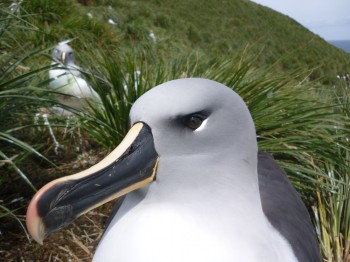
South Georgia holds the world's largest population of Grey-headed Albatrosses, of which c. 4000 pairs breed on Bird Island. This population has shown a dramatic long-term decline in recent decades, although with generally small numbers reported as bycatch, it is unclear whether this has resulted from major mortality in a poorly-monitored fishery, or from a deterioration in environmental conditions that has reduced breeding success or adult or juvenile survival.
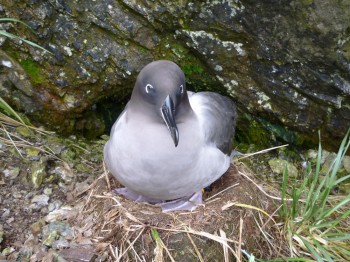
Less than 200 pairs of Light-mantled Sooty Albatrosses breed annually at Bird Island, and because many nest in inaccessible sites part-way down steep cliffs and the adults are sensitive to disturbance, there is much less information on this species than on the other albatrosses that breed on the island. However, it is known that they exploit distant feeding grounds, including shelf and shelf-slope areas from west of the southern tip of the South Sandwich Islands (Islas Sandwich del Sur )* to the South Shetland Islands; consequently, their foraging distances and maximum ranges are greater, and chick-feeding frequencies and growth rates are lower than in sympatric Black-browed or Grey-headed Albatrosses.
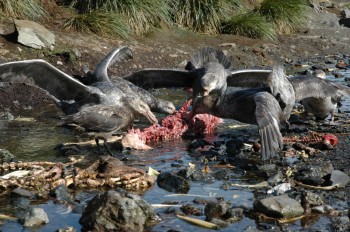
Male Northern Giant Petrels feed on a seal carcass on Bird Island
Photographs by Richard Phillips
The Northern Giant Petrel is one of the few ACAP-listed species to be increasing in numbers, and Bird Island now holds over 2000 breeding pairs. The males feed to a large extent during the early breeding season on the abundant supply of carrion from Antarctic Fur Seals Arctocephalus gazella available on the beaches at Bird Island, including placentae, dead pups and adult male seals that have succumbed to injuries sustained in fights for females.
Selected References:
Croxall, J.P., Prince, P.A., Rothery, P. & Wood, A.G. 1998. Population changes in albatrosses at South Georgia. In: Robertson, G. & Gales, R. (Eds). Albatross Biology and Conservation. Chipping Norton: Surrey Beatty and Sons. pp. 69-83.
Froy, H., Phillips, R. A., Wood, A.G., Nussey, D.H. & Lewis, S. 2013. Age-related variation in reproductive traits in the wandering albatross: evidence for terminal improvement following senescence. Ecology Letters DOI: 10.1111/ele.12092.
González-Solís, J., Croxall, J.P. & Wood, A.G. 2000. Sexual size dimorphism and sexual segregation in foraging strategies of northern giant petrels, Macronectes halli, during incubation. Oikos 90: 390-398.
Phillips, R.A., Silk, J.R.D. & Croxall, J.P. 2005. Foraging and provisioning strategies of the light-mantled sooty albatross at South Georgia: competition and co-existence with sympatric pelagic predators. Marine Ecology Progress Series 285: 259-270.
Phillips, R.A., Silk, J.R.D., Croxall, J.P., Afanasyev, V. & Bennett, V.J. 2005. Summer distribution and migration of nonbreeding albatrosses: individual consistencies and implications for conservation. Ecology 86: 2386-2396.
Poncet, S., Robertson, G., Phillips, R.A., Lawton, K., Phalan, B., Trathan, P.N. & Croxall, J.P. 2006. Status and distribution of wandering, black-browed and grey-headed albatrosses at South Georgia. Polar Biology 29: 772-781.
Richard Phillips, 25 March 2013
*A dispute exists between the Governments of Argentina and the United Kingdom of Great Britain and Northern Ireland concerning sovereignty over the Falkland Islands (Islas Malvinas), South Georgia and the South Sandwich Islands (Islas Georgias del Sur y Islas Sandwich del Sur) and the surrounding maritime areas.

 English
English  Français
Français  Español
Español